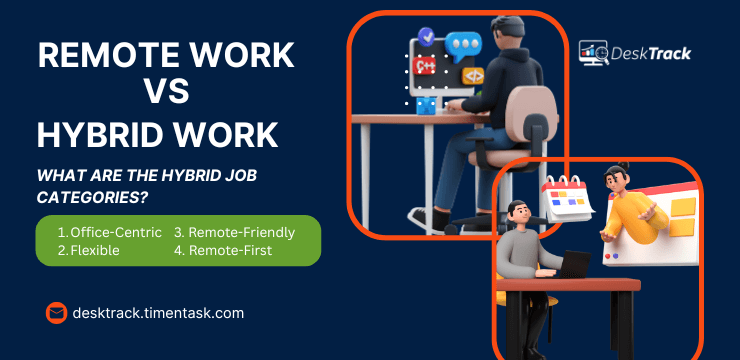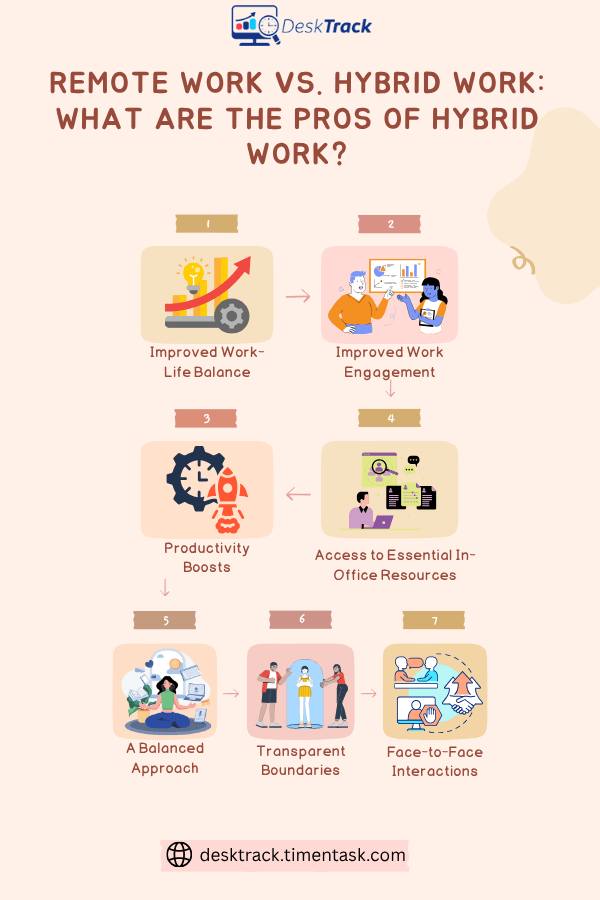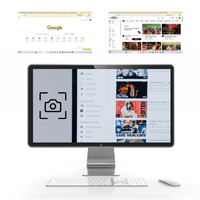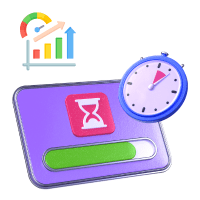
Remote work vs. hybrid work: which one is the right choice? You must also be asking yourself this question. Let’s face it, hardly anyone wants to clock in daily for in-office work. Neither do they deserve it. Such is life these days. In this fast-paced world, it is essential to manage both work and personal life without compromising the quality of either.
Here’s the truth. Doing so is impossible these days, when everyone is entitled to work in the office in the same 9:00 AM to 5:00 PM routine. However, choosing the right working model between remote and hybrid for your organization is not that easy.
You need to factor in many aspects, including employee requirements, industry, and most importantly, the employee monitoring software you will use. Nonetheless, after going through this blog, you will have no issues making a decision. As we always say, modern problems require modern solutions, we have the best solution for you. Continue reading to find out.
Remote Work vs. Hybrid Work: What You Need to Know About Each?
Make your workday more productive
Time tracking and work management can help you reach your goals
faster.
To summarize, the hybrid work model is a balanced integration of the in-office and work-from-anywhere infrastructures. Here, the schedules are either according to employee requirements or your organizational needs. For instance, if there is a need for in-person meetings or access to specific resources, your employees must clock in.
On the other hand, remote work encapsulates all teams working from anywhere, but your office. Simply put, fully remote employees don’t have access to a shared workspace or your office.
Read Also: Employee Engagement vs. Employee Experience: What’s the Difference?
Remote Work vs. Hybrid Work: What is Hybrid Work?
Now that you know a summary of both hybrid and remote work, we can start off with the details. First, we will take on the integration of work-from-home and in-office.
First, you need to know that the flexibility of the hybrid work model has skyrocketed its popularity among employees and organizations worldwide recently.
| Did you know that 5 out of 10 employees per business have hybrid schedules? |
Remote Work vs. Hybrid Work: What are the Hybrid Job Categories?

Well, admit it. You didn’t know that there were 4 categories of hybrid work. Did you? However, you will know soon enough. Plus, that also adds to the flexibility of this working model. So, let’s get right into it.
1. Office-Centric
This one is self-explanatory. As the name suggests, office-centric policies are the ones where staff have to do their jobs from the office, during most of the work week. However, the employees do have some flexibility regarding their work hours and the days they will work from anywhere.
2. Flexible
As the name suggests, the flexible work model provides your employees with flexible schedules. That is that your employees and teams have the full freedom to pick the time they spend working in and out of your office.
3. Remote-Friendly
Having a remote-friendly business provides you with total control over when and how your employees and teams work remotely. To give you some instances:
- You can set when your employees are not remote.
- You can set limits on which tasks can be done remotely.
4. Remote-First
Most of the staff members work remotely for the maximum hours per week. Thus, employees only gather in the office for crucial things.
| Did you know that you can implement any of these hybrid work types even department-wise? That’s another reason, this work structure is flexible and popular worldwide. These implementation rules are also applicable to in-office and remote policies, though. |
Remote Work vs. Hybrid Work: What are the Pros of Hybrid Work?

Like everything else, hybrid work also provides you and your employees with many advantages. So, what did you think? This work policy is only well-known for its flexibility. Here are 7 pros you will enjoy.
1. Improved Work-Life Balance
This one is obvious. Isn’t it? You can start working during your most productive peak time, take as many breaks as required, and end work when you feel like it. This leaves you with a lot of hours to attend to daily chores and think about why you got employed in the first place.
2. Improved Work Engagement
Improved work engagement and collaboration are what you experience next. That’s because you are in the office for a few days and not missing out on in-person communications. According to studies, this is also linked to positive employee engagement and enhanced well-being.
3. Productivity Boosts
Again, there are many studies that prove that employee productivity skyrockets due to flexible schedules. Yes, that’s all there is to it. No explanation is required.
4. Access to Essential In-Office Resources
Another bonus is that employees have access to shared workspaces and in-office resources. Here, team members:
- Meet in large groups.
- Converse one-on-one
- Work in individual cubicles
5. A Balanced Approach
This one is neither complete in-office nor fully work-from-anywhere. That’s why the work model is perfect for employees who want remote flexibility without having to lose in-person contact with each other.
6. Transparent Boundaries
Working from home all the time equates to your house being an extension of the office. The serious issue here is that you can also end up working odd hours. However, the integrated work model gets rid of this problem as you are also clocking in a few days and/or hours a week.
7. Face-to-Face Interactions
More of them. Whether it’s the remote-first, flexible, office-centric, or remote-friendly model, employees always get a chance to interact with each other in person from time to time.
Remote Work vs. Hybrid Work: What are the Limitations of Integrated Jobs?
On the contrary, hybrid work also comes with some disadvantages. So, you will have to weigh them in as well before implementing this model. Fortunately, there are only 6 cons.
1. Challenging Transition
If you have a remote or in-office work setting, transitioning to the integrated model can be a challenge. That’s because:
- You have to balance new work dynamics
- You also have to look into the management of productivity fluctuations.
For the same, you also need the right employee monitoring software to keep track of the online and offline employee activity in this new atmosphere.
2. Difficult Onboarding
Onboarding is more complex than you think. You need a more structured and well-planned approach to candidacy, onboarding, performance growth, and exit because the integrated model lacks the spontaneity and ease of in-person interactions.
3. Complex Meetings
Conducting meetings with both in-office and remote teams can get complex very fast. You need to ensure that work-from-anywhere employees are also equally heard, involved, and attended to. Doing so can be a challenge.
4. Infrastructural Expenses
Directly implementing a hybrid workplace atmosphere can be expensive. You need to think of all the expenditures required to gather resources and build workstations. However, if you already have an office, transitioning to this new policy will be less expensive.
5. Participation Inequality
Due to the presence of in-office employees, remote teams can often feel like having a hard time participating and contributing to the conversation. This will put too much pressure on remote employees to clock in, even if they want to work from home.
6. Less Flexible
This is only in the scenario of the office-centric business. Here, your employees work more from the office per week than from other places. Some employees may even feel this rollercoaster is more mentally disturbing.
Remote Work vs. Hybrid Work: What is Remote Work?

On the other hand, we have remote work. Simply put, when employees are working remotely in full, they can work from home, school, or anywhere. Here are a few more things to know about this work policy.
- As we mentioned before, remote teams and employees don’t have a shared workspace or office.
- Around 3 out of 10 employees in the USA alone are completely remote.
- Most HRs in Fortune 500 businesses don’t plan to reduce work-from-anywhere options in the future.
Remote Work vs. Hybrid Work: What are the Pros of Remote Work?
Remote work employees and employers enjoy many advantages over in-office and integrated teams. Here are the 6 pros you will experience.
1. Flexible Schedules
Out of all the work models we know about, employees in remote atmospheres have the most flexible schedules. If given the chance, around 90% of employees would opt for a more flexible working option. As we mentioned before, remote employees set their schedules to:
- Work around their most productive hours.
- Suit their personal lives.
2. Reduced Office Costs
As an employer, you will enjoy reduced or eliminated overhead and/or office costs. That’s because there is no physical location. So, you are saving up due to no:
- Rental and mortgage payments
- Monthly utility fees
- Furniture
- Office supplies
3. Broader Talent Pool
Having work-from-anywhere employees gives you a more open network and a broader chance to have a larger talent pool. This is because you are not limited to local hiring and can recruit new employees from anywhere as well.
4. More Creativity
As per an expert study, employees working remotely show more creativity than in-office or hybrid teams. This led to performance improvements because employees were able to freely use their skills without constantly being nagged all the time.
5. More Focus
That’s because of all the comforts of working from home or your favourite cafe. Since there is no noise or distraction from a co-worker or two stopping by for a quick chat, you can fully concentrate on the task at hand.
6. No Commute
Going to the office means a routine. That means dressing up to impress, preparing your lunch, and, if you have kids, giving them a promise to return and a happy memory before leaving for work. However, if you are working fully remotely, this commute no longer exists. So, you can just wake up and start working if you feel like it.
Remote Work vs. Hybrid Work: What are the Cons of Remote Work?
Likewise, remote work environments also provide you and your employees with some typical headaches. Again, you need to weigh in on these 6 cons before switching to the work-from-anywhere model.
1. Challenging Collaboration
Communication and collaboration go hand in hand. Since there is reduced and/or no in-person communication in remote settings, collaboration is also a challenge. While video conferencing and virtual meeting platforms can be helpful, it’s still tough to schedule meetings, especially if your employees are dispersed across multiple time zones. Plus, did you know that remote teams are more difficult to engage?
2. No Boundaries
Establishing and maintaining boundaries without purposeful intent is impossible. Remote teams and employees find it harder to glue to specific work hours if laptops and other devices are readily available.
3. Security Risks
Furthermore, if you have a distributed workforce, you can’t deny the security risks that come with it. We mean, how will you identify where the data breach occurred from? The costs are also high to implement advanced security software and prevent insider threats. That is, unless you are using the best screenshot monitoring software.
4. Fewer Face-to-Face Interactions
Employees can also find remote environments isolating or alienating. That’s because no colleagues are hanging around. However, we don’t know if this is also true for your introverted employees.
5. Reduced Cross-Functional Visibility
When your employees are working in an in-office setting, seeing what other teams are doing and learning from them is easy. However, working from anywhere but the office takes this privilege away. You already know why it is so.
6. More Effort for Collaboration
In-person collaboration is much easier. All you have to do is walk up to or cycle to another person’s desk. However, for instance, these steps are necessary in remote settings.
- Send an email
- Request a time on the calendar
- Set up a video chat
These extra efforts make employees and teams less willing to work together.
Read Also: 15 Productivity Tips for Small Businesses: Must-Know Hacks & Strategies
Remote Work vs. Hybrid Work: Which One Should You Choose?

So, now you know the differences, pros, and cons of both of these job models. However, you still need to consider a few things before choosing between remote and hybrid work:
1. The Sensible Choice
It’s essential to consider your industry and other factors before going fully hybrid or remote. For example:
- If you have employees dispersed across various nations and time zones, then the integrated work model is not a good idea for obvious reasons.
- However, a healthcare business can go hybrid. For instance, doctors only have to come to the workplace in emergency cases.
2. Support
Whether you select the hybrid or remote model, it’s always essential to support your employees. Here are some tips for the same.
- Utilize transparent communication channels, like email, video conferencing, and chat spaces.
- For hybrid workforce support, it’s crucial to implement the right software to simplify tedious tasks, such as booking office resources like meeting rooms and desks.
- You also need to ensure that your remote teams and employees have enough opportunities to collaborate and work together.
- Providing opportunities for hybrid and remote employees to give and receive feedback, ask questions, clock in regularly, utilize project management tools, and raise concerns is also crucial.
- Consider its effect on customers. Maintaining a high level of customer service, even if teams are working remotely, is essential.
3. Employee Preference
Although the final decision is up to you, it’s also essential to consider what your employees prefer. You can easily find that out through:
- Surveys
- Listening in on discussions, gossip, and conversations by having lunch with your employees.
4. Employee Location
For instance, if you have more local teams, then the office-centric work model will also work great. However, you can’t even think of Hybrid, let alone implement it, if you have geographically dispersed employees across multiple time zones.
Remote Work vs. Hybrid Work: Why Do You Need DeskTrack to Monitor Both?
So, whether you opted for remote or hybrid work, or preferred to stay in-office, you need the best integrated project management, employee monitoring, productivity monitoring, and time tracking software to go along. With DeskTrack, you can keep checks on your remote, hybrid, in-office, and on-site teams while sitting in your office in real-time. From screenshot monitoring for security to app, URL, and file usage tracking for boosting productivity, the software solution does it all. Plus, did we mention that it’s the most cost-effective tool in this category?
Conclusion
Now, we hope that you have wrapped your head around the complete guide to remote work vs. hybrid work. All the commotion going around these two work models is about which one is the best for you and your teams. As a final word, we can say that both the remote and integrated work settings have their fair share of pros and cons, with different challenges and rewards for you and your employees. Furthermore, you also need to weigh in the budget required and employee preferences before making a final decision. Plus, don’t forget that you will also need the best monitoring tools for streamlining workflows and keeping work integrity in check. For doing all that while keeping your data secure from potential breaches, we recommend using DeskTrack for your remote, hybrid, on-site, and in-office employees.
Frequently Asked Questions (FAQ)
Q. What is the Difference Between Remote & Hybrid Work?
Ans. The hybrid work model is a balanced integration of the in-office and work-from-anywhere infrastructures. Here, the schedules are either according to employee requirements or your organizational needs. For instance, if there is a need for in-person meetings or access to specific resources, your employees must clock in. On the other hand, remote jobs involve employees working from anywhere, but your office. Simply put, fully remote employees don’t have access to a shared workspace or your office.
Q. Does Hybrid mean Work-from-Home or Work-from-Office?
Ans. The answer is neither. Hybrid work is a balanced integration of both work-from-home and work-from-office environments.
Q. What is an Example of a Hybrid Job?
Ans. A practical instance of hybrid work includes two or three days from the office per week. This can be set either by the employer or the employees, as per the organization’s policies.
Q. What are the Categories of Hybrid Jobs?
Ans. The integrated remote and in-office work policy has 4 types:
- Office-Centric
- Flexible
- Remote-Friendly
- Remote-First
Q. What is 100% Remote Work?
Ans. Remote work encapsulates teams working from anywhere, but your office. Simply put, fully remote employees don’t have access to a shared workspace or your office.










